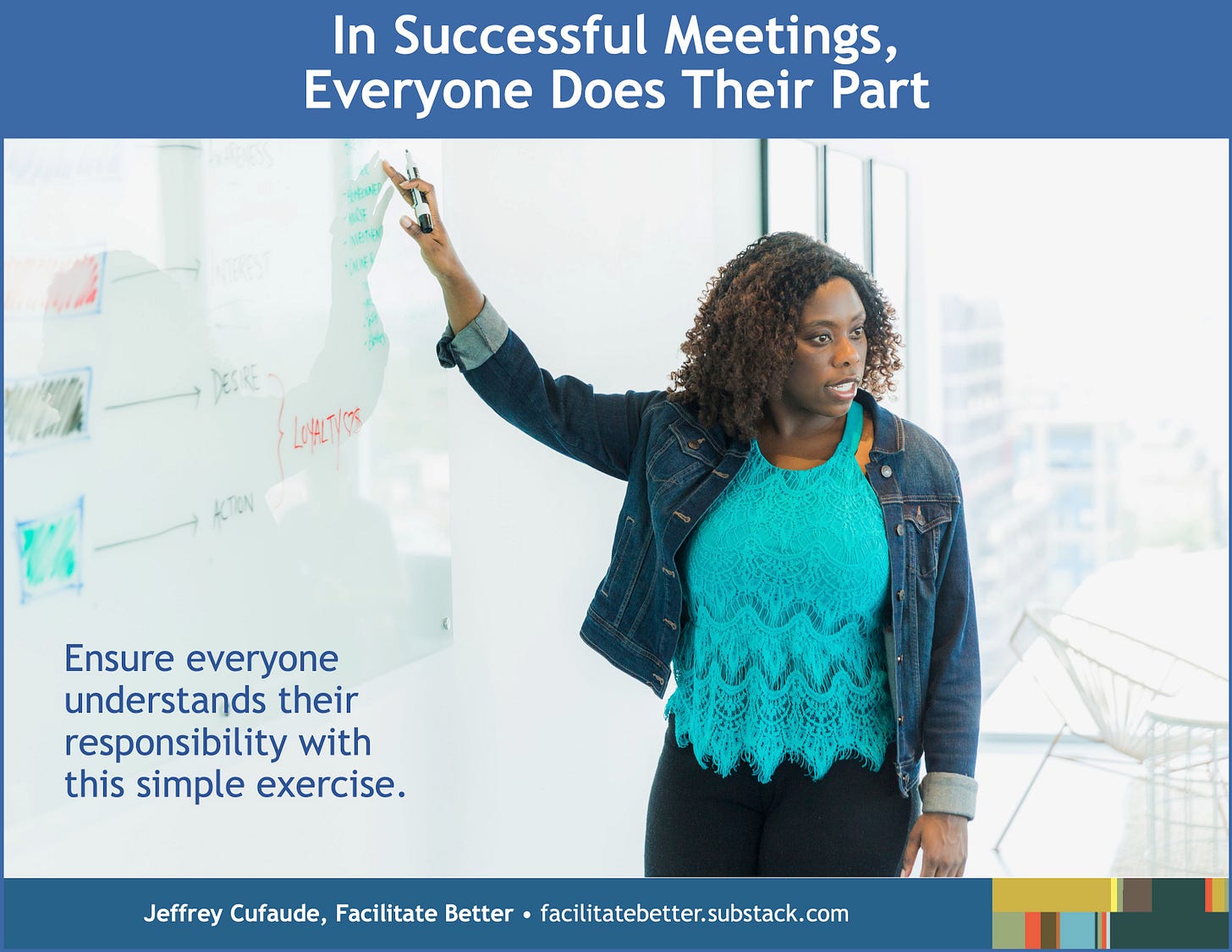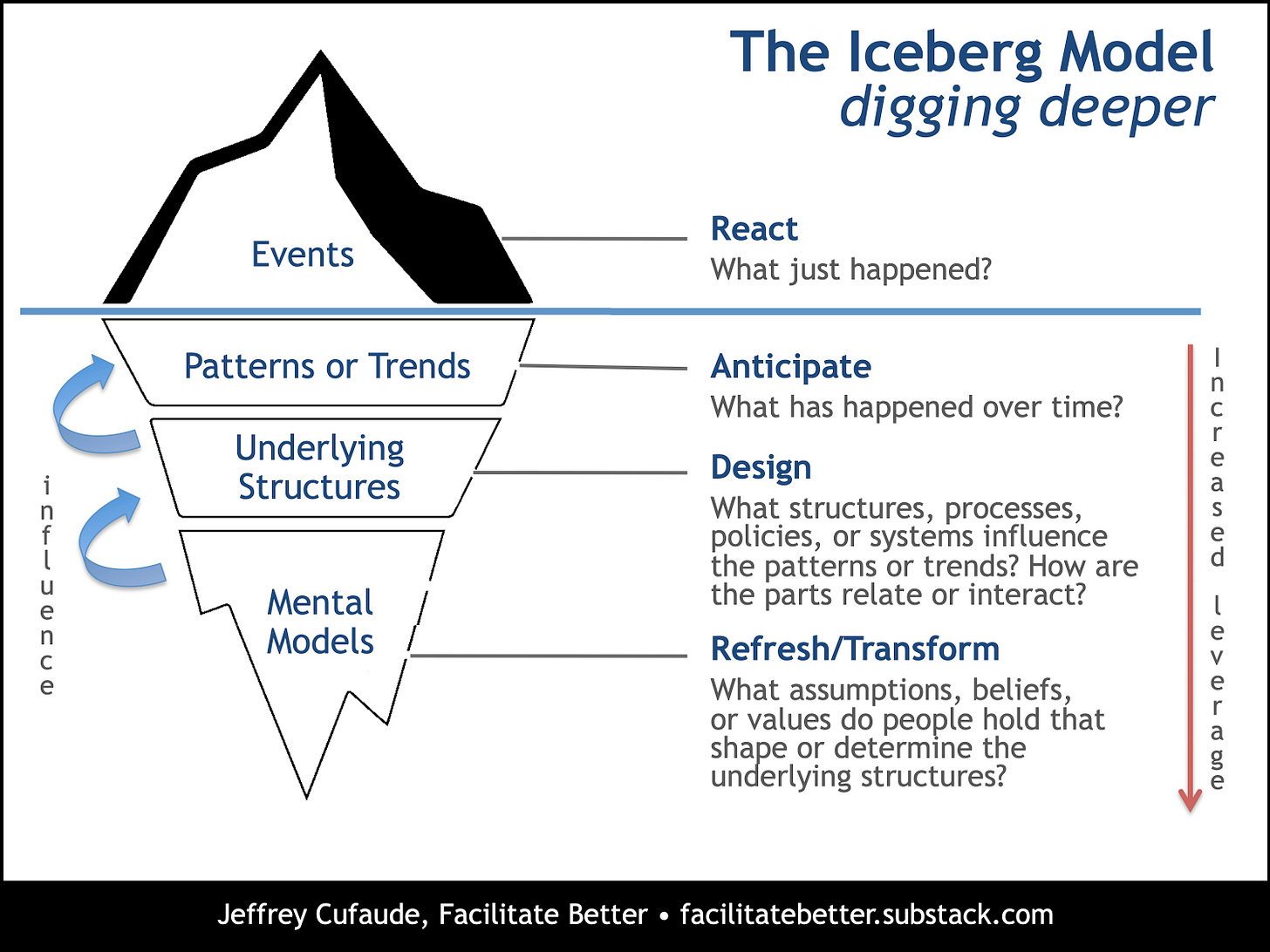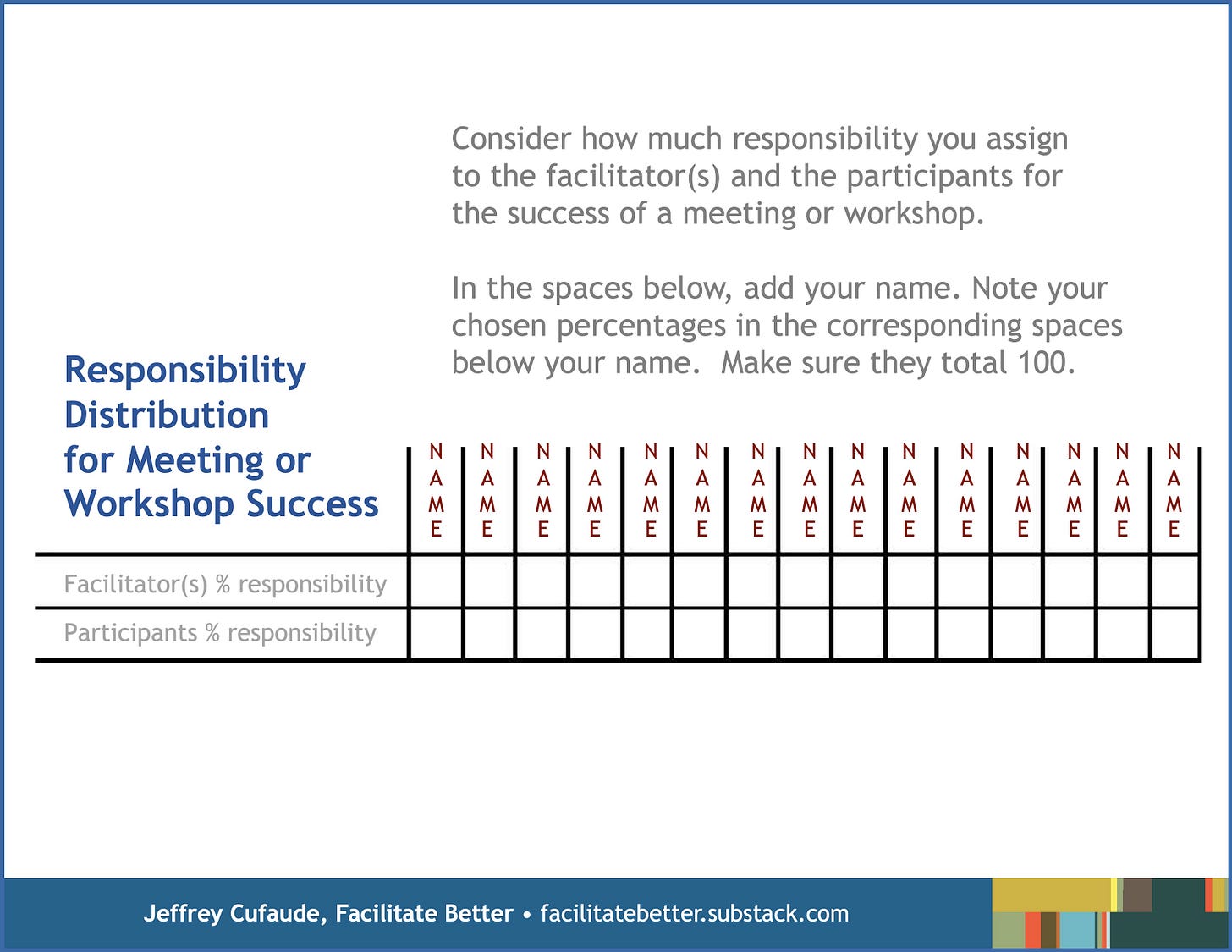In Successful Meetings, Everyone Does Their Part (Facilitation Friday #72)
Facilitators make a lasting contribution when we enable greater interdependence among participants and less dependence on us.
Who is most responsible for a meeting’s success?
The facilitator or the participants?
While everyone has some degree of a responsibility for what happens during a gathering, some participants are content to let facilitators have complete control over an event. This is not good.
In one of my initial posts, I note why this sometimes happens:
“Too much responsibility often is assigned to the designated facilitator or presenter. In addition, facilitation frequently is considered the sole domain of the department head, the board or committee chair, or the consultant leading a planning process. This marginalizes the potential facilitative contributions participants can make, as well as their responsibility for (and ownership of) the outcomes.”
Many people still operate under this limiting mindset as a facilitator or participant. It is one reason why I don’t think any facilitator can 100% guarantee what results can be delivered for a meeting or workshop.
Mindsets and Mental Models
Mental models operate deep within an organization’s culture, influencing the systems, policies, practices. Collectively they shape group norms and individual behaviors as the Iceberg Model illustrates. Changing participants’ behavior and contributions (what is seen at the iceberg “event” level) often requires diving deeper to explore and challenge the unseen mental models and mindsets that influence them.
Mindset Check: Yours
Think of a typical meeting. For each party below, assign a percentage of responsibility that you believe it generally bears for whether or not a meeting is successful. Make sure your choices total 100.
__________ The facilitator(s) __________ The participants
What influenced the choices you made and/or how did you come to this mindset?
What are the group process implications of the distributions you noted?
How might you adjust your future facilitation efforts based on your reflections?
Believing they have a disproportionate percentage of responsibility for the success of a meeting or workshop may be one reason some facilitators get nervous or anxious before it. They become overly burdened and every choice they make feels more consequential.
While a facilitator’s mindset matters a great deal, so do participants’ mindsets and expectations. Many think they bear too little responsibility for a gathering’s group process or achieving the stated outcomes.
Mindset Check: Participants
For each party below, assign a percentage of responsibility you think typical participants believe it generally bears for whether or not a meeting is successful. Make sure your choices total 100.
__________ The facilitator(s) __________ The participants
What influenced the choices you made and/or how did you come to this mindset?
What are the group process implications of the distributions you noted?
How might you adjust your future facilitation efforts based on your reflections?

Exploring Success as a Shared Responsibility
How much responsibility facilitators or participants assume in a meeting has a domino effect influencing the responsibility-related actions and reactions of the other party. As Roger Martin’s Responsibility Cycle from The Responsibility Virus shows, the consequences of over- or under-responsibility can be significant.
Participants often prescribe significant power, authority, and responsibility to the facilitator(s). This can result in the facilitator’s efforts being seen or experienced as more important or influential … like weighted questions on an exam.
A facilitator who exerts too much control over for an event’s group process, regardless of the reasons for doing so, can unintentionally send the message that participants’ facilitative contributions are not needed, or even worse, not welcome. This is why I stress that effective facilitation provides group process leadership while generally operating with restraint.
In contrast, facilitation that is too passive or “under-responsible” can frustrate participants, waste valuable time, and require participants’ take on disproportionate responsibility to achieve an event’s outcomes. They may be unwilling or incapable of doing so.
Ideally, facilitators create a meeting or workshop environment where all participants embrace the responsibility and accountability for group process leadership appropriate given the gathering’s outcomes and participants’ roles and relationships with each other. Developing and effectively using shared agreements and coaching participants to make facilitative contributions helps do so as does clarifying roles and discussing shared responsibilities with participants.
Here is a simple way to surface participants’ perceptions about responsibility and accountability and facilitate a conversation about their implications.
The Responsibility Graph exercise
Explain that the success of meetings or workshops is a shared responsibility and that this exercise will explore participants’ mindsets about the distribution of responsibility between participants and facilitators.
Have people form a single-file line down the center of the room. Label (indicate) one wall as FACILITATOR(S) and the wall across from it (PARTICIPANTS).
Ask participants to imagine a number line traversing the two walls and note that they currently stand at a 50-50 distribution of responsibility between facilitators and participants. Invite them to move in either direction to a position that accurately represents who they believe holds more responsibility for a meeting’s (or workshop’s) success and the degree to which they do. The closer they move to one of the walls, the more responsibility they believe that party has for a gathering’s success. They can stay where they are if they believe the distribution is 50-50 between participants and the facilitator(s).
Once participants take their position, invite them to look at everyone’s positions. Solicit any initial reactions as desired before facilitating an open discussion about the distribution of choices and the implications of them. Ask a sampling of participants in different positions to share their reasoning and what their chosen distribution might look like in action during a meeting or workshop. Close by introducing and briefly discussing Roger Martin’s Responsibility Cycle.
For virtual groups, you can replicate this human graph exercise with a whiteboard. Add a center line. Label one end of the line FACILITATOR(S) and the other end PARTICIPANTS. Instead of selecting where to stand, ask your attendees to add their initials in the space that reflects their perceived distribution of responsibility.
Note: in lieu of the graph you could have participants complete the allocation exercise from the start of this essay and then post/share their responses in a manner that allows everyone’s choices to be seen at once. I typically use an Excel document in virtual sessions or provide the equivalent on newsprint for in-person sessions.
Application
After any allocation exercise, you may also want to negotiate an agreement for (and shared commitment to) a distribution that differs from what participants selected, particularly when it varies greatly from your own. II find this especially helpful with groups I facilitate regularly. Always explore what that revised allocation of responsibility would like in action to help make it more concrete.
Bottom Line
Facilitators should never go it alone even if for some reason we want to do so or the group wants us to. Enabling a commitment to shared responsibility not only helps achieve any individual event’s outcomes, it can also increase a group’s long-term capacity to better self-manage their efforts. Facilitators make a lasting contribution when we enable greater interdependence among participants and less dependence on the facilitator(s).
Getting in Action
Complete the initial responsibility allocation exercise and action planning questions for different types of gatherings you (may) facilitate; i.e., workshops, strategic planning sessions, team retreats, et al. Why might you perceive different distributions for specific types of gatherings and what might that mean for your facilitation?
In what settings or with what types of participants are you more likely to deviate (increase or decrease) from your typical facilitator responsibility level? Why might that be and what can you learn from this tendency?
Think of the different participants you facilitate. When and why might they be more likely to assume less responsibility and accountability for a gathering’s success? In addition to the suggestions in this essay, how might you explore this with them and get them committed to increasing their facilitative contributions?
© Facilitate Better and Jeffrey Cufaude, 2023. All rights reserved.
To affordably license this content for reprint on your site or in electronic or print communications or to contact me regarding customized facilitation skills workshops or consultations, email me or complete this form.







